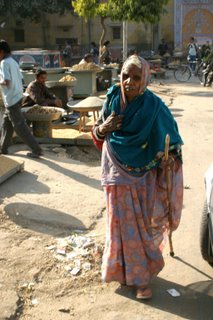India - Choki Dani
Choki Dani is a traditional Rajasthani cultural village (and I use the word "traditional" a little loosely). The previous day I ran into my friend Laura at our guesthouse in Jaipur (she had attended the same textile show I was in Delhi). It was such an unexpected surprise to see her. She and her boyfriend Tom were heading to Choki Dani for dinner and asked me to join them. We arrived and decided to visit the various cultural exhibits before dinner. - magic shows, fire throwing, puppet shows, fortune telling, oh, and camel riding. I was at the jewelers shop (of course) when I heard a familiar laugh coming from the other side of the village (yes, she was THAT loud). Following the familiar noise of my friend, I found her atop a rather tall camel cracking up. She said it was one of the funniest things she had ever done, so I thought I would give it a go. Since she had so much fun the first time, she said she would go again. Listen very carefully in the second video for my scream as the camel came down to rest so we could get off. I'm still laughing about the experience.
All the camel escapades worked us into an appetite frenzy, so we headed into the tent for dinner. Laura, Tom and I all sat in wonderment as they served us the various traditional Rajasthani food. Having no idea what we were actually eating, we just smiled and prayed we would live. I forgot to bring a water bottle, so I had to drink the water they poured into my tiny terracotta cup. I took as tiny sips as possible thinking, "oh my gosh, what am I DOING, I'm not going to survive the Indian water!!" My mom has always said that alcohol kills tiny organisms so we got our driver to stop and get beer on the way home. There we were, huge bottles of beers in hand, in this beautiful white ambassador classic taxi, Laura and Tom arm in arm in the back. We felt like we were in the middle of a James Dean movie. It was quite a picture.
I did survive the meal, didn't get sick (miraculously) and savored the experience. It was so interesting to see the different ways that the Hindi people have preserved their culture and traditional arts. It was one of the highlights of my trip to India.

All the camel escapades worked us into an appetite frenzy, so we headed into the tent for dinner. Laura, Tom and I all sat in wonderment as they served us the various traditional Rajasthani food. Having no idea what we were actually eating, we just smiled and prayed we would live. I forgot to bring a water bottle, so I had to drink the water they poured into my tiny terracotta cup. I took as tiny sips as possible thinking, "oh my gosh, what am I DOING, I'm not going to survive the Indian water!!" My mom has always said that alcohol kills tiny organisms so we got our driver to stop and get beer on the way home. There we were, huge bottles of beers in hand, in this beautiful white ambassador classic taxi, Laura and Tom arm in arm in the back. We felt like we were in the middle of a James Dean movie. It was quite a picture.
I did survive the meal, didn't get sick (miraculously) and savored the experience. It was so interesting to see the different ways that the Hindi people have preserved their culture and traditional arts. It was one of the highlights of my trip to India.




























